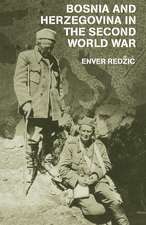The Pacific Campaign in World War II: From Pearl Harbor to Guadalcanal: Cass Series: Naval Policy and History
Autor William Bruce Johnsonen Limba Engleză Paperback – 19 mar 2010
Presenting previously unpublished photographs, interviews with veterans, newly commissioned maps and new translations of Japanese sources, this book freshly examines the key events in the fight for the Pacific.
Detailing the background to the Japanese attack on Pearl Harbor it shows how the decision-makers in Washington, following consultation with the leaders of Britain, Australia and New Zealand, moved to stop Japan from its drive toward Australia by initiating a counterthrust in the Solomon Islands.
It also shows how qualities and character of leadership are crucial to winning wars, detailing how Admiral Ernest J. King managed to commit the Marine Corps to ground action in the South Pacific six months earlier than originally planned, by ignoring the Roosevelt’s commitment to defeat Germany prior to fighting Japan, and by outmaneuvering Gen. Douglas MacArthur for leadership. It also explains how Marines under Maj. Gen. A.A. Vandegrift, despite inadequate logistical support, managed to prevail in the Americans’ first ground campaign of World War II, making Japan’s ultimate defeat inevitable.
In addition to recounting these key events, it traces how censorship and patriotism influenced the reporting of the conflict in America, how Hollywood films further shaped public opinion by portraying the significant events in particular ways, and how certain crucial decisions such as the early bombing raid of Tokyo, and giving Douglas MacArthur command of the war effort in Australia, were "political" rather than "strategic," and were made to foster morale rather than to gain any military advantage.
This book will be of great interest to all students and scholars of Military History, and to all readers with a general interest in World War II, particularly in the conflicts of the Pacific, Pearl Harbor and Guadalcanal.
| Toate formatele și edițiile | Preț | Express |
|---|---|---|
| Paperback (1) | 264.33 lei 24 ore | |
| Taylor & Francis – 19 mar 2010 | 264.33 lei 24 ore | |
| Hardback (1) | 1338.06 lei 6-8 săpt. | |
| Taylor & Francis – 8 dec 2005 | 1338.06 lei 6-8 săpt. |
Din seria Cass Series: Naval Policy and History
-
 Preț: 311.41 lei
Preț: 311.41 lei -
 Preț: 282.57 lei
Preț: 282.57 lei -
 Preț: 375.54 lei
Preț: 375.54 lei -
 Preț: 356.45 lei
Preț: 356.45 lei - 18%
 Preț: 1220.42 lei
Preț: 1220.42 lei -
 Preț: 411.04 lei
Preț: 411.04 lei - 18%
 Preț: 1166.68 lei
Preț: 1166.68 lei - 28%
 Preț: 853.97 lei
Preț: 853.97 lei - 23%
 Preț: 302.17 lei
Preț: 302.17 lei - 18%
 Preț: 1274.18 lei
Preț: 1274.18 lei - 18%
 Preț: 1056.95 lei
Preț: 1056.95 lei -
 Preț: 490.25 lei
Preț: 490.25 lei - 18%
 Preț: 1063.65 lei
Preț: 1063.65 lei - 28%
 Preț: 821.53 lei
Preț: 821.53 lei -
 Preț: 412.57 lei
Preț: 412.57 lei -
 Preț: 471.33 lei
Preț: 471.33 lei - 18%
 Preț: 1056.00 lei
Preț: 1056.00 lei - 28%
 Preț: 820.71 lei
Preț: 820.71 lei -
 Preț: 465.49 lei
Preț: 465.49 lei - 16%
 Preț: 299.06 lei
Preț: 299.06 lei - 15%
 Preț: 423.93 lei
Preț: 423.93 lei -
 Preț: 412.03 lei
Preț: 412.03 lei - 18%
 Preț: 1280.80 lei
Preț: 1280.80 lei -
 Preț: 497.58 lei
Preț: 497.58 lei -
 Preț: 490.46 lei
Preț: 490.46 lei -
 Preț: 448.10 lei
Preț: 448.10 lei -
 Preț: 487.86 lei
Preț: 487.86 lei - 18%
 Preț: 1330.65 lei
Preț: 1330.65 lei - 33%
 Preț: 324.59 lei
Preț: 324.59 lei - 18%
 Preț: 1225.36 lei
Preț: 1225.36 lei - 18%
 Preț: 1057.13 lei
Preț: 1057.13 lei - 18%
 Preț: 1058.19 lei
Preț: 1058.19 lei - 18%
 Preț: 1002.68 lei
Preț: 1002.68 lei - 28%
 Preț: 823.63 lei
Preț: 823.63 lei - 28%
 Preț: 825.25 lei
Preț: 825.25 lei - 18%
 Preț: 1060.74 lei
Preț: 1060.74 lei - 28%
 Preț: 822.54 lei
Preț: 822.54 lei -
 Preț: 445.22 lei
Preț: 445.22 lei - 18%
 Preț: 1115.51 lei
Preț: 1115.51 lei - 18%
 Preț: 1001.84 lei
Preț: 1001.84 lei - 18%
 Preț: 1283.92 lei
Preț: 1283.92 lei
Preț: 264.33 lei
Nou
50.58€ • 52.81$ • 41.77£
Carte în stoc
Livrare din stoc 06 martie
Specificații
ISBN-10: 041558714X
Pagini: 430
Dimensiuni: 156 x 234 x 22 mm
Greutate: 0.8 kg
Ediția:1
Editura: Taylor & Francis
Colecția Routledge
Seria Cass Series: Naval Policy and History
Locul publicării:Oxford, United Kingdom
Public țintă
General, Postgraduate, Professional, and UndergraduateCuprins
1. The Pacific Background 2. Why Japan Gambled 3. The Last Clear Chance 4. The Long Postmortem 5. The Course of Empire 6. Bataan Through Midway 7. The Counterthrust 8. The First Two Days 9. The Battle of Savo Island 10. Settling In 11. Up Against It 12. A Mixed Picture 13. Courage and Ambivalence 14. Medical Issues 15. The End of the Beginning
Notă biografică
William Bruce Johnson is a New York-based attorney and a professional writer specializing in government policy and its consequences in the middle decades of the twentieth century.
Recenzii
--Proceedings
Descriere
This is a fascinating new account of how diplomacy and politics gave way to military strategy and warfare in the Pacific.
Presenting previously unpublished photographs, interviews with veterans, newly commissioned maps and new translations of Japanese sources, this book freshly examines the key events in the fight for the Pacific.
Detailing the background to the Japanese attack on Pearl Harbor it shows how the decision-makers in Washington, following consultation with the leaders of Britain, Australia and New Zealand, moved to stop Japan from its drive toward Australia by initiating a counterthrust in the Solomon Islands.
It also shows how qualities and character of leadership are crucial to winning wars, detailing how Admiral Ernest J. King managed to commit the Marine Corps to ground action in the South Pacific six months earlier than originally planned, by ignoring the Roosevelt’s commitment to defeat Germany prior to fighting Japan, and by outmaneuvering Gen. Douglas MacArthur for leadership. It also explains how Marines under Maj. Gen. A.A. Vandegrift, despite inadequate logistical support, managed to prevail in the Americans’ first ground campaign of World War II, making Japan’s ultimate defeat inevitable.
In addition to recounting these key events, it traces how censorship and patriotism influenced the reporting of the conflict in America, how Hollywood films further shaped public opinion by portraying the significant events in particular ways, and how certain crucial decisions such as the early bombing raid of Tokyo, and giving Douglas MacArthur command of the war effort in Australia, were "political" rather than "strategic," and were made to foster morale rather than to gain any military advantage.
This book will be of great interest to all students and scholars of Military History, and to all readers with a general interest in World War II, particularly in the conflicts of the Pacific, Pearl Harbor and Guadalcanal.












